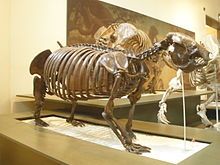- Megalocnus
-
Megalocnus
Temporal range: .126–.011 Ma Late PleistoceneMounted skeleton of Megalocnus rodens
American Museum of Natural History, New York CityScientific classification Kingdom: Animalia Phylum: Chordata Class: Mammalia Superorder: Xenarthra Order: Pilosa Family: Megalonychidae Genus: †Megalocnus
Leidy, 1868Species - †M. rodens
- †M. zile
The ground sloths of the extinct genus Megalocnus ("Great Sloth") were among the largest of the Caribbean ground sloths, with individuals estimated to have weighed up to 90 kg (200 lb) when alive. Two species are known, M. rodens of Cuba, and M. zile of Hispaniola. Subfossils of M. rodens indicate survival well into the Holocene, prompting speculation that they may have survived in the montane forests of the Cuban highlands until the 15th or 16th century. However, the most recent AMS radiocarbon date reported is 4190 BP, calibrated to c. 4700 BP.[1] This is similar to the most recent date reported for a Hispaniolan sloth, 4391 BP, calibrated to c. 5000 BP, for the small and probably arboreal Neocnus comes,[2] and some 1200 years after the earliest known date for human occupation of Cuba, 5140 BP, calibrated to c. 5900 BP.[1]
Their relatives include other Caribbean ground sloths, such as Acratocnus, Mesocnus, Miocnus, Neocnus, Parocnus, and Paulocnus.
References
- ^ a b MacPhee, R. D. E.; Iturralde-Vinent, M. A.; Vázquez, O. J. (June, 2007). "Prehistoric Sloth Extinctions in Cuba: Implications of a New "Last" Appearance Date". Caribbean Journal of Science (College of Arts and Sciences, University of Puerto Rico) 43 (1): 94–98. http://caribjsci.org/June07/43_94-98.pdf. Retrieved 2009-05-11.
- ^ Steadman, D. W.; Martin, P. S.; MacPhee, R. D. E.; Jull, A. J. T.; McDonald, H. G.; Woods, C. A.; Iturralde-Vinent, M.; Hodgins, G. W. L. (2005-08-16). "Asynchronous extinction of late Quaternary sloths on continents and islands". Proc. Natl. Acad. Sci. USA (National Academy of Sciences) 102 (33): 11763–11768. doi:10.1073/pnas.0502777102. PMC 1187974. PMID 16085711. http://www.pnas.org/content/102/33/11763.abstract. Retrieved 2009-01-24.

This prehistoric mammal-related article is a stub. You can help Wikipedia by expanding it.

